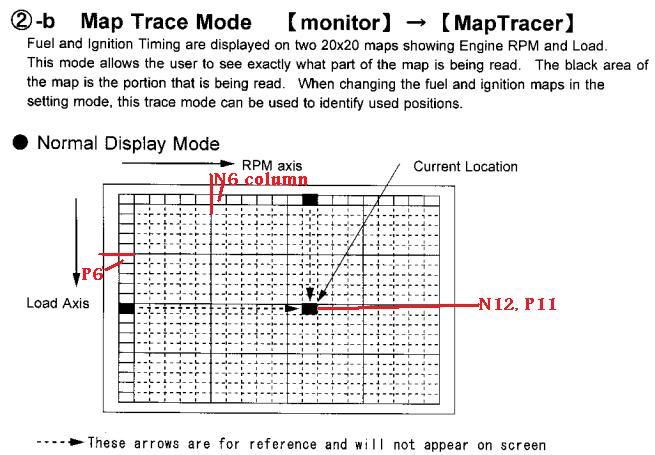HOW TO: Make your untuned PFC basemap safer/idle better (no Datalogit needed)
#1
HOW TO: Make your untuned PFC basemap safer/idle better (no Datalogit needed)
--Note: revised 11/22/2010 per Raymond's request to clarify/revise certain points - Gracer7-rx7
First I want to credit Chuck Westbrook for a lot of my PFC knowledge and thank him for his many contributions to this forum. He has passed on his PFC tuning notes to me. If you have a Datalogit or just want to know more about the PFC you can send me a PM about the notes package.
Key words:
idle surging, boost creep, PFC, safety, knock, detonate, tune, Commander, Power, FC, AFR
I have dished out this advice in bits and pieces in other people's threads, and now I want to put together a full writeup for all PFC users running an untuned unit on the base map who just have a Commander at their disposal. This is not a substitute for a real tune, just a way for owners to get some incremental improvements in driveability and safety.
Introduction
Most people have PFC model #414-Z004 (look on the box) if they have a 92-95 car. The basemap isn't so bad. The leading timing map, while not perfect, is safe for most setups (including many single turbo setups IMO), and the trailing timing just needs a few minutes of tediously changing values across-the-board to make it safer. Fuel can be made safer using a fuel correction feature that is buried in the Commander's menus. The idle problems that people encounter with the PFC can take a lot of time to figure out, but I'm going to give a basic strategy to try before you give the car to a professional. I also personally think the PFC controls boost fine as long as you understand how it works and set it up properly, but unfortunately the documentation for this feature is sketchy.
Idle
One of the first things owners may notice when they get a PFC is that their idle may be surging. The PFC is simply more sensitive than the factory ECU is, as OEM computers tend to be pretty forgiving. Usually the culprit is too much air getting past the throttle plates, or a lean mixture due to an untuned correction map. I'm just going to give the advice that is usually given around here. What you are going to do is decrease the amount of air entering past the throttle plates, and then see if the PFC will adjust to this new condition.
Remove/back off the TB elbow. Tighten the air adjust screw all the way in, then back it out 1/4 to 1/2 turn, then reinstall the elbow.
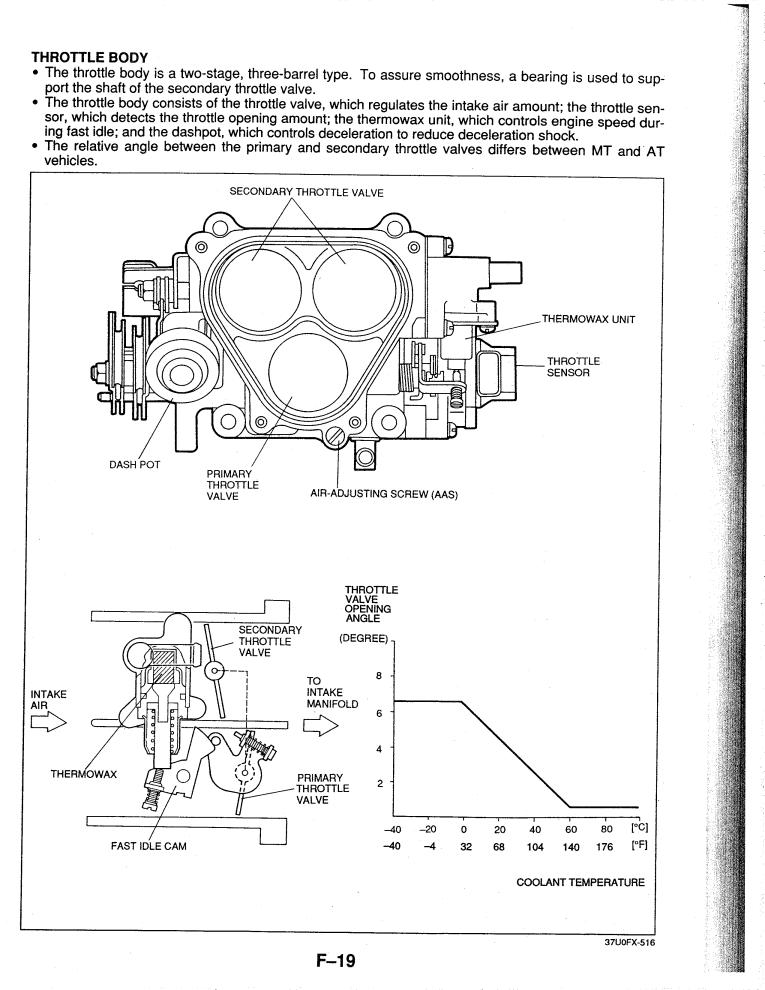
Now reset the Power FC at Etc. --> all data init (you will lose all your settings from this). Then turn off O2 feedback (your stock O2 sensor now does nothing) under Etc. --> Function select. There should be some funny Japanese -ooking characters there. Perform the idle learning procedure as outlined in the PFC manual:
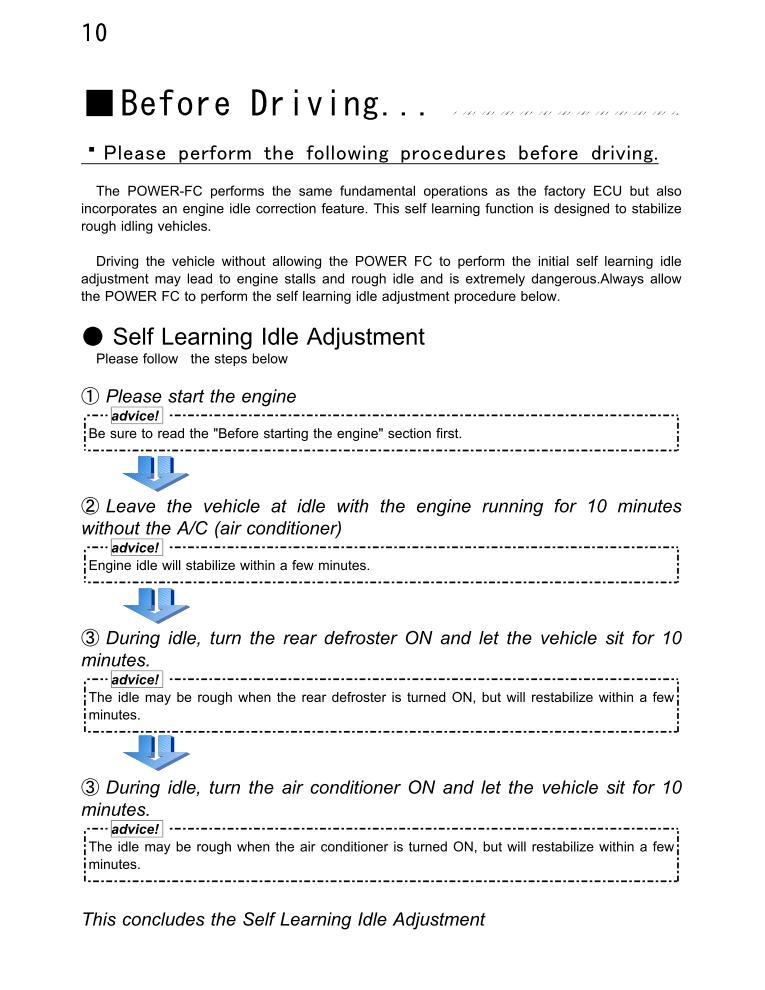
Don't tighten that screw in all the way. If you can't figure the idle out, leave it to your tuner. Or get Chuck's tuning notes and read the sections on setting the idle with the ISC unplugged/removed. He also has a more thorough discussion of how to adjust all the TB screws.
Timing
Here is the leading timing map for Power FC model #414-Z002 , the early production ones that most people don't have. Supposedly this is very similar to the stock ECU's timing map. X axis is RPM (the "N" columns in the Commander), Y axis represents MAP (the "P" rows in the Commander). 10000 units is about 1 bar, so at 10psi boost you are at something near 17000 units. (.70 kg/cm^2 or so, 1 kg cm^2 = ~14.22 psi I think ) The boost readings on the Commander are not completely accurate without recalibrating the MAP sensor using a Datalogit. The PFC usually reads a little bit lower than a mechanical gauge without this calibration.
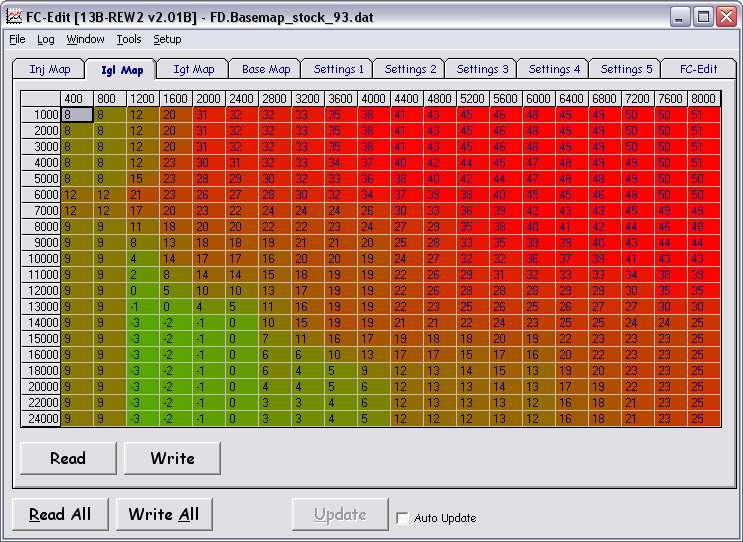
Now here is the leading timing map for Power FC model #414-Z004, the model that most people have. Notice less leading timing advance in the boost area? A higher number means the plug fires earlier, a lower number means the plug fires later and there will be less chance of detonation.
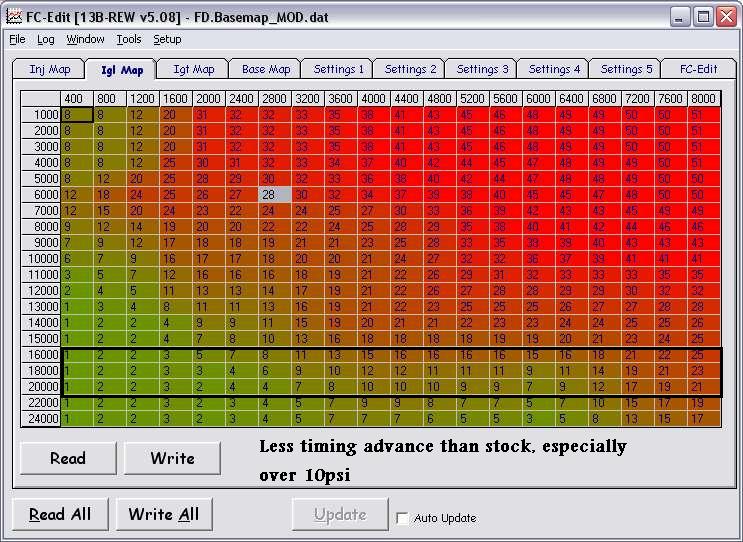
The basemap trailing timing on the PFC model #414-Z004 , the model that most people have, is less safe once you get over about 10psi (and the timing progression is sloppy). But the safety aspect is correctable even with a Commander just by tediously going through the IGT screen, rows P16-P18 (8.5psi to 14 psi range), and retarding the timing (decrease the timing value) by about 4 degrees in every cell over say 2400 rpm (N7 and higher columns in the commander). So take whatever value is in a particular cell, subtract 4 from it, and then input that new value in the cell.
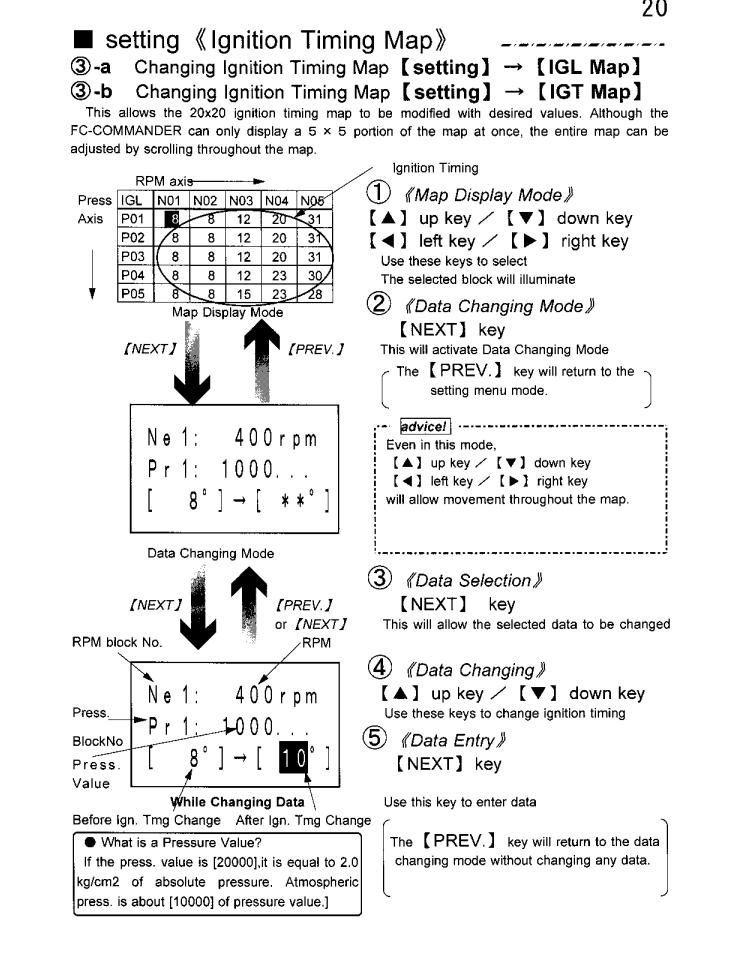
Fuel
To make the fuel safer (provided that your fuel pump and injectors can flow enough) you can quickly add fuel across the board based on RPM. It is a sub menu under setting --> PIM volt.
Get to the RPM correction screen and add whatever % fuel you think may be necessary. While cars with less mods may need no adjustments at all, more modded cars could start with 105-110%. You can fiddle with it more if you have a wideband. I'm pretty sure the RPM based correction would affect your AFR's under cruising as well.
You could also do boost-based compensation (the bottom screen there) but since it is in MAP sensor voltage you would be doing a lot of guesswork. Just try to get the AFR under boost to be somewhere in the 11.0-11.5 range, but don't go too rich because the car will worse and build up a lot of carbon. Remember that we are doing this to decrease the chance of the car detonating, not tuning for power.
Protecting Your Motor With Overboost Fuel Cut
Without some form of overboost protection, you can blow your engine up in the event of boost control failure. Overboost fuel cut isn't the only way to protect your engine from boost control failure, but it is the simplest to implement. Later in this thread (page 2) I will discuss how to calculate the values you need to set an overboost fuel cut at whatever boost level you want.
These guideline values apply only for engines running an external boost controller (EBC, MBC) with the stock MAP sensor using the default MAP sensor calibration.
If you intend to run 10psi of boost with an external controller, set all boost settings in the boost menu to .55 kg/cm^2 .
If you intend to run 12psi of boost with an external controller, set all boost settings in the boost menu to .70 kg/cm^2 .
If you intend to run 14psi of boost with an external controller, set all boost settings in the boost menu to .95 kg/cm^2 .
To make the fuel cut more likely to kick in (PFC allows less overboosting), lower this value in .05 increments. To make it less likely to kick in (PFC allows more overboosting), raise this value in .05 increments. If you feel like the engine has "hit a brick wall" you may have hit fuel cut, so you need to check all aspects of your boost control system.
Boost Control
This applies for engines running the PFC as a boost controller. The default settings (option 1 in the boost menu):
Boost (in Kg/cm^2) Precontrol/Wastegate solenoid duty cycles
Primary .80 56%
Secondary .70 64%
Besides affecting the fuel cut, think of the boost value as a "coarse" adjustment to your boost, while the duty % is a "fine" adjustment to the boost. I usually set the primary value to the same value as the Secondary number. If you are overboosting, start by setting boost to
Pr .70 56%
Sc .70 56%
And if you have to, try going back and forth with lowering both the boost and duty values. Otherwise I would leave it to the tuner or just get a separate boost controller. Remember that playing with the boost setting in the commander will not fix a mechanical limitation such as an undersized wastegate.
I have done extensive testing of the PFC boost control logic on a sequential car and it is documented in this thread: https://www.rx7club.com/power-fc-forum-47/pfc-wasgate-precontrol-710953/ from post #22 on. The PFC can also be used to control boost on a single turbo or non sequential twin turbo car but that's a little more involved than I want to cover here.
Conclusion
The PFC base leading map, coupled with some adjustments to the trailing map and a fuel correction adjustment will make your car much safer to drive until you can get a proper tune done with someone you are comfortable with.
First I want to credit Chuck Westbrook for a lot of my PFC knowledge and thank him for his many contributions to this forum. He has passed on his PFC tuning notes to me. If you have a Datalogit or just want to know more about the PFC you can send me a PM about the notes package.
Key words:
idle surging, boost creep, PFC, safety, knock, detonate, tune, Commander, Power, FC, AFR
I have dished out this advice in bits and pieces in other people's threads, and now I want to put together a full writeup for all PFC users running an untuned unit on the base map who just have a Commander at their disposal. This is not a substitute for a real tune, just a way for owners to get some incremental improvements in driveability and safety.
Introduction
Most people have PFC model #414-Z004 (look on the box) if they have a 92-95 car. The basemap isn't so bad. The leading timing map, while not perfect, is safe for most setups (including many single turbo setups IMO), and the trailing timing just needs a few minutes of tediously changing values across-the-board to make it safer. Fuel can be made safer using a fuel correction feature that is buried in the Commander's menus. The idle problems that people encounter with the PFC can take a lot of time to figure out, but I'm going to give a basic strategy to try before you give the car to a professional. I also personally think the PFC controls boost fine as long as you understand how it works and set it up properly, but unfortunately the documentation for this feature is sketchy.
Idle
One of the first things owners may notice when they get a PFC is that their idle may be surging. The PFC is simply more sensitive than the factory ECU is, as OEM computers tend to be pretty forgiving. Usually the culprit is too much air getting past the throttle plates, or a lean mixture due to an untuned correction map. I'm just going to give the advice that is usually given around here. What you are going to do is decrease the amount of air entering past the throttle plates, and then see if the PFC will adjust to this new condition.
Remove/back off the TB elbow. Tighten the air adjust screw all the way in, then back it out 1/4 to 1/2 turn, then reinstall the elbow.

Now reset the Power FC at Etc. --> all data init (you will lose all your settings from this). Then turn off O2 feedback (your stock O2 sensor now does nothing) under Etc. --> Function select. There should be some funny Japanese -ooking characters there. Perform the idle learning procedure as outlined in the PFC manual:

Don't tighten that screw in all the way. If you can't figure the idle out, leave it to your tuner. Or get Chuck's tuning notes and read the sections on setting the idle with the ISC unplugged/removed. He also has a more thorough discussion of how to adjust all the TB screws.
Timing
Here is the leading timing map for Power FC model #414-Z002 , the early production ones that most people don't have. Supposedly this is very similar to the stock ECU's timing map. X axis is RPM (the "N" columns in the Commander), Y axis represents MAP (the "P" rows in the Commander). 10000 units is about 1 bar, so at 10psi boost you are at something near 17000 units. (.70 kg/cm^2 or so, 1 kg cm^2 = ~14.22 psi I think ) The boost readings on the Commander are not completely accurate without recalibrating the MAP sensor using a Datalogit. The PFC usually reads a little bit lower than a mechanical gauge without this calibration.

Now here is the leading timing map for Power FC model #414-Z004, the model that most people have. Notice less leading timing advance in the boost area? A higher number means the plug fires earlier, a lower number means the plug fires later and there will be less chance of detonation.

The basemap trailing timing on the PFC model #414-Z004 , the model that most people have, is less safe once you get over about 10psi (and the timing progression is sloppy). But the safety aspect is correctable even with a Commander just by tediously going through the IGT screen, rows P16-P18 (8.5psi to 14 psi range), and retarding the timing (decrease the timing value) by about 4 degrees in every cell over say 2400 rpm (N7 and higher columns in the commander). So take whatever value is in a particular cell, subtract 4 from it, and then input that new value in the cell.

Fuel
To make the fuel safer (provided that your fuel pump and injectors can flow enough) you can quickly add fuel across the board based on RPM. It is a sub menu under setting --> PIM volt.
Get to the RPM correction screen and add whatever % fuel you think may be necessary. While cars with less mods may need no adjustments at all, more modded cars could start with 105-110%. You can fiddle with it more if you have a wideband. I'm pretty sure the RPM based correction would affect your AFR's under cruising as well.
You could also do boost-based compensation (the bottom screen there) but since it is in MAP sensor voltage you would be doing a lot of guesswork. Just try to get the AFR under boost to be somewhere in the 11.0-11.5 range, but don't go too rich because the car will worse and build up a lot of carbon. Remember that we are doing this to decrease the chance of the car detonating, not tuning for power.
Protecting Your Motor With Overboost Fuel Cut
Without some form of overboost protection, you can blow your engine up in the event of boost control failure. Overboost fuel cut isn't the only way to protect your engine from boost control failure, but it is the simplest to implement. Later in this thread (page 2) I will discuss how to calculate the values you need to set an overboost fuel cut at whatever boost level you want.
These guideline values apply only for engines running an external boost controller (EBC, MBC) with the stock MAP sensor using the default MAP sensor calibration.
If you intend to run 10psi of boost with an external controller, set all boost settings in the boost menu to .55 kg/cm^2 .
If you intend to run 12psi of boost with an external controller, set all boost settings in the boost menu to .70 kg/cm^2 .
If you intend to run 14psi of boost with an external controller, set all boost settings in the boost menu to .95 kg/cm^2 .
To make the fuel cut more likely to kick in (PFC allows less overboosting), lower this value in .05 increments. To make it less likely to kick in (PFC allows more overboosting), raise this value in .05 increments. If you feel like the engine has "hit a brick wall" you may have hit fuel cut, so you need to check all aspects of your boost control system.
Boost Control
This applies for engines running the PFC as a boost controller. The default settings (option 1 in the boost menu):
Boost (in Kg/cm^2) Precontrol/Wastegate solenoid duty cycles
Primary .80 56%
Secondary .70 64%
Besides affecting the fuel cut, think of the boost value as a "coarse" adjustment to your boost, while the duty % is a "fine" adjustment to the boost. I usually set the primary value to the same value as the Secondary number. If you are overboosting, start by setting boost to
Pr .70 56%
Sc .70 56%
And if you have to, try going back and forth with lowering both the boost and duty values. Otherwise I would leave it to the tuner or just get a separate boost controller. Remember that playing with the boost setting in the commander will not fix a mechanical limitation such as an undersized wastegate.
I have done extensive testing of the PFC boost control logic on a sequential car and it is documented in this thread: https://www.rx7club.com/power-fc-forum-47/pfc-wasgate-precontrol-710953/ from post #22 on. The PFC can also be used to control boost on a single turbo or non sequential twin turbo car but that's a little more involved than I want to cover here.
Conclusion
The PFC base leading map, coupled with some adjustments to the trailing map and a fuel correction adjustment will make your car much safer to drive until you can get a proper tune done with someone you are comfortable with.
Last edited by gracer7-rx7; 04-26-11 at 11:06 PM. Reason: revised 11/22/2010 per Raymond's request to clarify/revise certain points - Gracer7-rx7
#3
a couple things. when you reset the Power FC before the idle learning procedure, you must turn the key off and back on immediately after you select the reset option from the menu.
the other thing is the fuel injector correction menu, which I meant to put in the first post as I refer to the pictures in it:
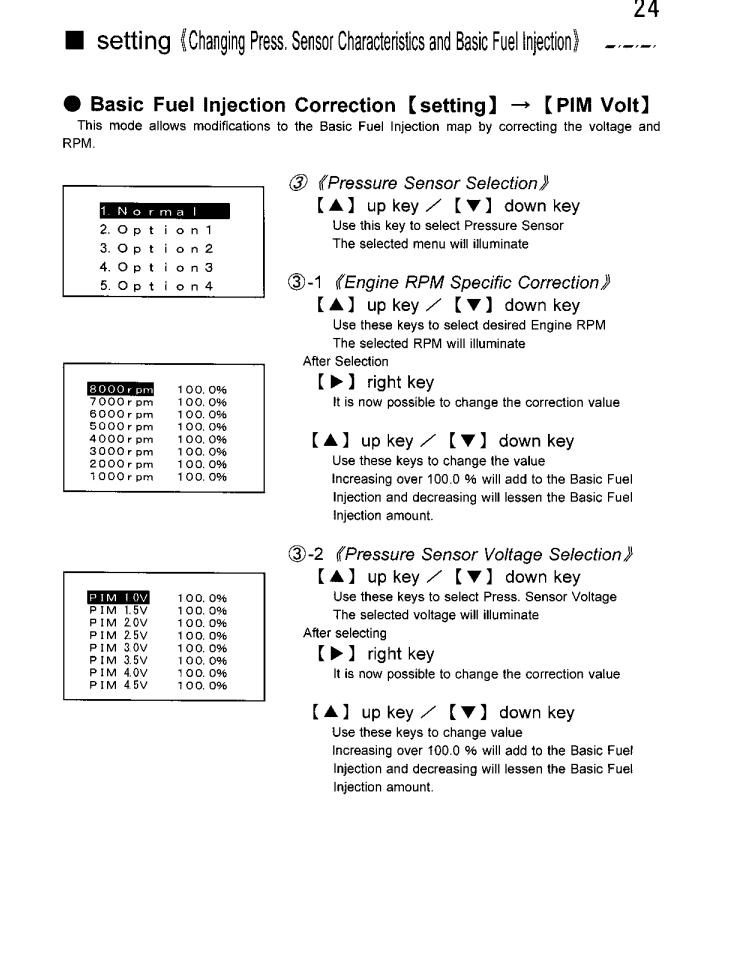
the other thing is the fuel injector correction menu, which I meant to put in the first post as I refer to the pictures in it:

#4
I have personally never used the pressure sensor voltage (boost-based as opposed to rpm-based) fuel enrichment map in the diagram above. But I will say that according to my Datalogit logs, 10psi is a little less than 4 volts on the default MAP sensor calibration. So if you want to ramp up enrichment when it hits near full boost, you could try something like this:
PIM 1.0V 100%
PIM 1.5V 100%
PIM 2.0V 100%
PIM 2.5V 100%
PIM 3.0V 100%
PIM 3.5V 102%
PIM 4.0V 105%
PIM 4.5V 105%
I wouldn't use both the rpm and the pressure sensor voltage table at the same time though.
PIM 1.0V 100%
PIM 1.5V 100%
PIM 2.0V 100%
PIM 2.5V 100%
PIM 3.0V 100%
PIM 3.5V 102%
PIM 4.0V 105%
PIM 4.5V 105%
I wouldn't use both the rpm and the pressure sensor voltage table at the same time though.
#6
I've used the same techniques on my car, thanks for posting this, you obviously put a lot of time and effort into this, it's very much appreciated. YOu can do quite a bit with the commander, but to really take advantage of PFC, you need a datalogit  (I know the point of the thread is that no datalogit is needed)
(I know the point of the thread is that no datalogit is needed)
 (I know the point of the thread is that no datalogit is needed)
(I know the point of the thread is that no datalogit is needed)
#7
I know this thread is about doing this without a datalogit, however, for those of us who do have a datalogit, do you have this optimized basemap available for datalogit users ?
Thanks,
:-) neil
Thanks,
:-) neil
Trending Topics
#8
I don't think it would be appropriate for me to post maps here. What I have suggested can be done with a Datalogit in 30 seconds if you know how to use the program. Timing can be adjusted by selecting multiple cells at once and using the "-" key to retard. The same menus from the Commander that I discussed are also in the Datalogit software in similar form. That's all I'm going to say about that, I want to keep this thread focused.
#10
In the section on boost control, I mentioned a set of boost values to try if you happened to be overboosting some:
Pr .70 56%
Sc .70 56%
.70 kg/cm^2 is 10psi when you do the math (multiply by 14.22). But the problem is, the PFC usually reads lower than a mechanical gauge unless you change the MAP sensor calibration with a Datalogit. So you may actually have to try a lower boost level like .65 or .60 if you want to stay at 10psi according to whatever gauge you have.
After a WOT run, press the up key on the Commander in Monitor mode. That will display peak boost. If the target boost values are set to .70 and peak boost reads .70 kg/cm^2 (10psi), the PFC is actually doing its job. But your mechanical gauge may read 11psi (because of the sensor calibration issue), in which case you may mistakenly think something is messed up when it's just two measuring devices disagreeing with each other.
So at that point, if you want to see 10psi on your mechanical gauge you should reduce your target boost. Drop both the "primary" and "secondary" target boost values in .05 kg/cm^2 increments each time and see if that helps. Clear the peak boost value (press the up key to enter peak-hold mode and the right arrow key to clear) before each run.
Adjust duty values if necessary depending on whether you are overboosting or underboosting before or after transition. See https://www.rx7club.com/3rd-generation-specific-1993-2002-16/why-engine-so-damn-complicated-part-1-sequential-turbos-demystified-841821/ , scroll towards the bottom of post #9, the section titled "A possible method for setting PFC boost control duty."
So the rule is:
After a WOT pull (2nd or 3rd gear), check the peak boost using peak-hold mode. If the peak boost in the PFC mostly agrees with the target boost setting, you need to adjust the target boost setting if you are not happy with what you see on your mechanical gauge. That's to compensate for the MAP sensor calibration issue. If the peak boost is significantly off from the target value in the PFC, you need to adjust the duty cycles.
Pr .70 56%
Sc .70 56%
.70 kg/cm^2 is 10psi when you do the math (multiply by 14.22). But the problem is, the PFC usually reads lower than a mechanical gauge unless you change the MAP sensor calibration with a Datalogit. So you may actually have to try a lower boost level like .65 or .60 if you want to stay at 10psi according to whatever gauge you have.
After a WOT run, press the up key on the Commander in Monitor mode. That will display peak boost. If the target boost values are set to .70 and peak boost reads .70 kg/cm^2 (10psi), the PFC is actually doing its job. But your mechanical gauge may read 11psi (because of the sensor calibration issue), in which case you may mistakenly think something is messed up when it's just two measuring devices disagreeing with each other.
So at that point, if you want to see 10psi on your mechanical gauge you should reduce your target boost. Drop both the "primary" and "secondary" target boost values in .05 kg/cm^2 increments each time and see if that helps. Clear the peak boost value (press the up key to enter peak-hold mode and the right arrow key to clear) before each run.
Adjust duty values if necessary depending on whether you are overboosting or underboosting before or after transition. See https://www.rx7club.com/3rd-generation-specific-1993-2002-16/why-engine-so-damn-complicated-part-1-sequential-turbos-demystified-841821/ , scroll towards the bottom of post #9, the section titled "A possible method for setting PFC boost control duty."
So the rule is:
After a WOT pull (2nd or 3rd gear), check the peak boost using peak-hold mode. If the peak boost in the PFC mostly agrees with the target boost setting, you need to adjust the target boost setting if you are not happy with what you see on your mechanical gauge. That's to compensate for the MAP sensor calibration issue. If the peak boost is significantly off from the target value in the PFC, you need to adjust the duty cycles.
#11
I feel like a fool for not finding this thread earlier. Doh! Awesome info here. I'm going to be late for work now... but totally worth it!
BTW, would you still suggest a tune by a competent tuner (either w/ experience using the Commander or Datalogit) for a car that is just running stock ports, stock twins, w/ downpipe and exhaust?
Thanks again. This info is long overdue and you delivered big-time!
BTW, would you still suggest a tune by a competent tuner (either w/ experience using the Commander or Datalogit) for a car that is just running stock ports, stock twins, w/ downpipe and exhaust?
Thanks again. This info is long overdue and you delivered big-time!
#12
--Note revised 11/22/2010 to correct/clarify a few points at Raymond's request. - Gracer7-rx7
The answer to the question is that it depends on the car, it depends on the tuner, and it depends what you are going to get from the tune.
I see a more limited value in the kind of professional tune where the tuner sits there at the dyno and essentially reproduces what I just suggested in this thread. That would be starting from the default map and then making minor timing adjustments while checking that the AFR under a WOT dyno pull is ok. As I've demonstrated, it doesn't take that long to mess with a few settings to reduce the chance of your car from blowing up, especially if you have a little knowledge and a wideband. You can add fuel and pull timing under an hour if you are comfortable attempting that yourself. Or you can go online and figure out what other people are doing for AFR's and timing on a given setup, reproduce that and cross your fingers.
I've especially seen local professionals at smaller shops who have more outward confidence than experience and knowledge. It's like taking your retirement fund to an investment manager with credentials on paper and yet he can't do any better than you could have done at a given level of investment risk. The PFC basemap really needs driveability tuning, especially cruising and idle AFR's. The default map is designed to get your car starting, idling, and driving while hopefully not causing engine damage to a car with a certain level of modifications. Tuning the low load AFR's is the kind of thing that takes a lot of time and changes with different setups. So if you take the car to a tuner, he's going to do one of 4 things:
1) He can mostly ignore driveability or spend only a small amount of time on it trying to do some custom tuning for AFR's under low load. I'd expect this especially from a tuner who isn't an Rx-7 and Power FC specialist, but rather runs an "Import Shop." If you think about it, they can't really charge the full hourly value for building a full custom driveability tune. It would cost you the customer too much. It's just an unprofitable road for a shop that's trying to keep the lights on.
2) He can go through a large library of his own maps and load one that matches your setup as closely as he can manage. The specialists are going to have this kind of library, and the more common your setup the better that map will work out-of-the-box. Nowhere near as much time is needed to make the individual car run better in this case because the work has been done beforehand in building the library of maps. I would expect this type of work from traveling tuners especially.
3) He can spend lots of time on the car for all these driveability aspects and lose money or barely break even on the amount of work put into it. I've seen local shops lose their shirts on this kind of work (not necessarily Rx-7's but other custom cars).
4) He can spend a decent amount of extra time on it if necessary, probably working off a map that he already had, and make a profit based on how much he's charging (tiered pricing plan) and whether you are paying him for other services as part of a package. I suspect a lot of the big guys do this.
There can be a lot of gray areas in the realm of tuning once you get past the standby rule of "don't run too much timing or too little fuel under boost, however you define 'too much' or 'too little."
I see a more limited value in the kind of professional tune where the tuner sits there at the dyno and essentially reproduces what I just suggested in this thread. That would be starting from the default map and then making minor timing adjustments while checking that the AFR under a WOT dyno pull is ok. As I've demonstrated, it doesn't take that long to mess with a few settings to reduce the chance of your car from blowing up, especially if you have a little knowledge and a wideband. You can add fuel and pull timing under an hour if you are comfortable attempting that yourself. Or you can go online and figure out what other people are doing for AFR's and timing on a given setup, reproduce that and cross your fingers.
I've especially seen local professionals at smaller shops who have more outward confidence than experience and knowledge. It's like taking your retirement fund to an investment manager with credentials on paper and yet he can't do any better than you could have done at a given level of investment risk. The PFC basemap really needs driveability tuning, especially cruising and idle AFR's. The default map is designed to get your car starting, idling, and driving while hopefully not causing engine damage to a car with a certain level of modifications. Tuning the low load AFR's is the kind of thing that takes a lot of time and changes with different setups. So if you take the car to a tuner, he's going to do one of 4 things:
1) He can mostly ignore driveability or spend only a small amount of time on it trying to do some custom tuning for AFR's under low load. I'd expect this especially from a tuner who isn't an Rx-7 and Power FC specialist, but rather runs an "Import Shop." If you think about it, they can't really charge the full hourly value for building a full custom driveability tune. It would cost you the customer too much. It's just an unprofitable road for a shop that's trying to keep the lights on.
2) He can go through a large library of his own maps and load one that matches your setup as closely as he can manage. The specialists are going to have this kind of library, and the more common your setup the better that map will work out-of-the-box. Nowhere near as much time is needed to make the individual car run better in this case because the work has been done beforehand in building the library of maps. I would expect this type of work from traveling tuners especially.
3) He can spend lots of time on the car for all these driveability aspects and lose money or barely break even on the amount of work put into it. I've seen local shops lose their shirts on this kind of work (not necessarily Rx-7's but other custom cars).
4) He can spend a decent amount of extra time on it if necessary, probably working off a map that he already had, and make a profit based on how much he's charging (tiered pricing plan) and whether you are paying him for other services as part of a package. I suspect a lot of the big guys do this.
There can be a lot of gray areas in the realm of tuning once you get past the standby rule of "don't run too much timing or too little fuel under boost, however you define 'too much' or 'too little."
Last edited by gracer7-rx7; 11-22-10 at 02:59 AM. Reason: revised 11/22/2010 to correct/clarify a few points at Raymond's request. - Gracer7-rx7
#13
Joined: Mar 2001
Posts: 30,580
Likes: 567
From: FL-->NJ/NYC again!
Great thread 
When adjusting the PIM volt menu, be sure to leave it on 'Normal,' when/if you accidentally move the cursor to Option1 the car will immediately run like ****
Also, keep in mind you're adding fuel based only on rpm, not boost. It's a temporary 'safety' bandaid but is not a proper tune because (among other things) it's not taking boost pressure/vacuum into account.
And you are correct, 1.0 kg/cm^2 does equal 14.22 psi.

When adjusting the PIM volt menu, be sure to leave it on 'Normal,' when/if you accidentally move the cursor to Option1 the car will immediately run like ****

Also, keep in mind you're adding fuel based only on rpm, not boost. It's a temporary 'safety' bandaid but is not a proper tune because (among other things) it's not taking boost pressure/vacuum into account.
And you are correct, 1.0 kg/cm^2 does equal 14.22 psi.
#16
--revised 11/22/2010 per Raymond's request to clarify/correct certain points - Gracer7-rx7
If it runs ok, LEAVE IT ALONE! I can't emphasize this enough. It's so easy to make the car run worse before it runs better. The O2 feedback can cause problems on some cars, but I know of some that run fine with it on (especially those with an airpump still). The car will be open-loop without O2 feedback, but the closed loop system was designed to run with the airpump still installed. As I said in my last post, there can be a lot of gray areas in tuning where rules become guidelines or just get thrown out altogether. This isn't a comprehensive tuning guide, just a seat-of-the-pants kind of thing.
There is also boost-based compensation menu that relies on pressure sensor voltage. I have never used it personally (no point when you have a Datalogit and know how to use it) but in a previous post I provided some guidelines to consider if you wish to experiment, namely that 10psi seems to be over 3.5 volts on a stock MAP sensor calibration.
Tuning Cruising AFR's
Here's a little technique I developed a couple years ago when I was first messing around with the Commander and didn't have a Datalogit. My friend and I were heading to Atlanta for the NOPI Nationals show in his FD. He was running on the PFC basemap and we were getting horrid highway mileage, maybe 13mpg. AFR's were maybe in the 11's on that car.
First, make sure the engine is at operating temperature (over 80C) so that the PFC isn't applying warm-up enrichment. Under the Setting ---> INJ map, your low-load cruising range in vacuum is something like N6-N10 columns, P3-P8 rows. The car can run pretty lean here, anywhere from 14:1 - 16:1. I personally run in the mid 15's in most of those cells, although you can't expect to have every cell perfect nor should you try. Running lean here doesn't damage anything. Worst case scenario, the car will stumble from lack of fuel and you'll need to add some back in.
If you want to try and adjust this, don't do anything dangerous while driving. Get a friend to drive the car in a safe and controlled environment. Have him hold a steady engine load with constant pedal position or cruise control so that the car isn't moving in between cells too much. You are going to use the map trace function to figure out what cells you are in, then switch back to the INJ map to start leaning things out.
This process requires you to look back and forth between the Commander and the wideband and be quick with switching between menus. Once you get the hang of it, it's still tedious but you can do it efficiently. A Datalogit drastically cuts the amount of time needed to do this because you can modify a bunch of cells at once and have your map trace function overlaid on the INJ map so you're not flipping around.
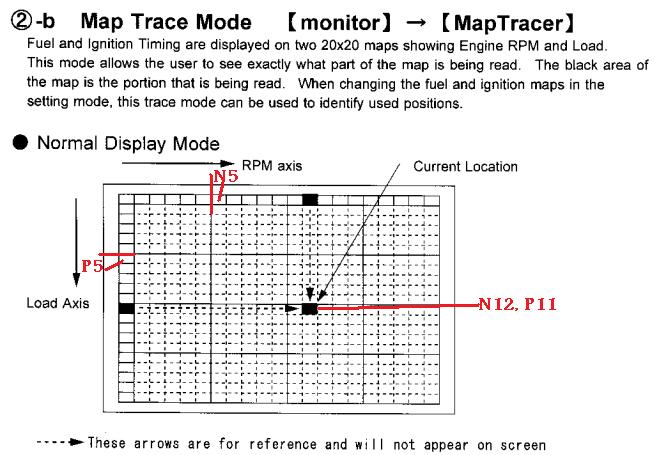
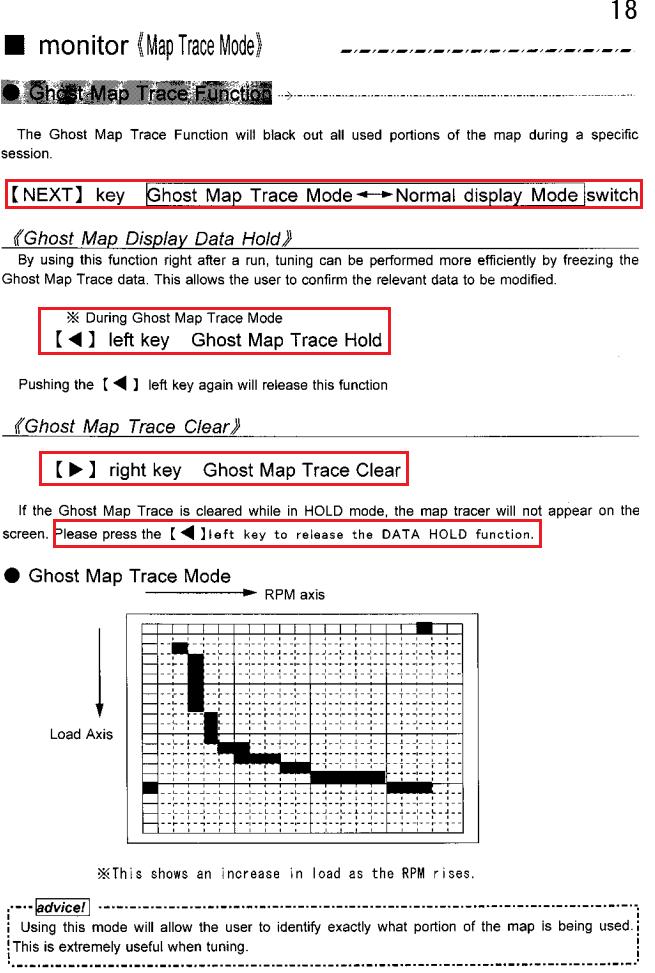
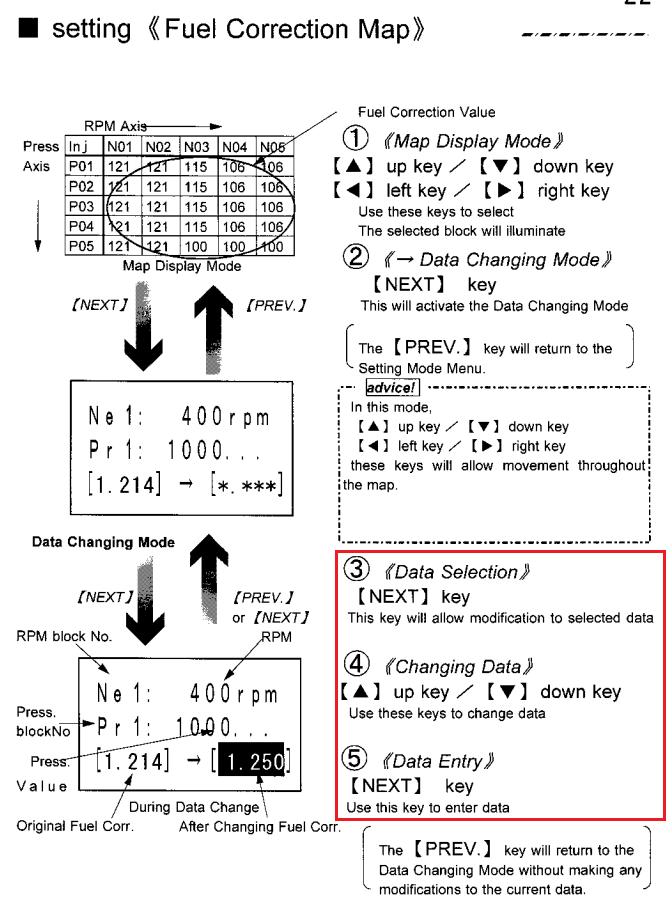
I would lean cells out about 5 percentage points at a time when you first start messing with it. So if the original value was 1.00 , drop it to .95 .
While you could use this technique to adjust the idle cells, you have to be really careful. Idle AFR's can swing widely with changing engine conditions and changing ambient conditions, especially on hot starts. I would discourage all but the most adventurous from messing with the idle AFR too much (if you've got 850 primary's, forget it). Once it gets over 13:1 (no airpump) the idle can get unstable pretty quickly and you can have all sorts of surging or hunting if you don't have it already. If you want to do serious idle tuning, get a Datalogit and PM Chuck Westbrook about tuning notes (cewrx7r1). It's pretty advanced stuff.
Cruising AFR tuning--the Cheap Bastard Way
I haven't personally had to do this, but if you don't have a wideband, you can tune cruising AFR's only with the factory narrowband O2 sensor. Instead of reading a wideband display, you will be checking factory O2 sensor voltage through the Commander. Here's a graph I ganked off Google showing the voltage range of a narrowband sensor.
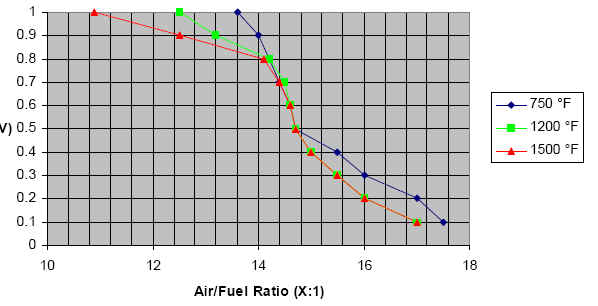
The voltage will fluctuate, but you want to aim for a range between .6 and .2 volts.

One last thing. If you end up making the car drive like crap and you can't figure it out, you can either 1) reset the Power FC and start everything all over again 2) just call a professional. If at any point you don't feel you are up to adjusting the PFC, get a professional. When in doubt, get a professional. I take no responsibility for anything you do with your PFC!
Also, keep in mind you're adding fuel based only on rpm, not boost. It's a temporary 'safety' bandaid but is not a proper tune because (among other things) it's not taking boost pressure/vacuum into account.
Tuning Cruising AFR's
Here's a little technique I developed a couple years ago when I was first messing around with the Commander and didn't have a Datalogit. My friend and I were heading to Atlanta for the NOPI Nationals show in his FD. He was running on the PFC basemap and we were getting horrid highway mileage, maybe 13mpg. AFR's were maybe in the 11's on that car.
First, make sure the engine is at operating temperature (over 80C) so that the PFC isn't applying warm-up enrichment. Under the Setting ---> INJ map, your low-load cruising range in vacuum is something like N6-N10 columns, P3-P8 rows. The car can run pretty lean here, anywhere from 14:1 - 16:1. I personally run in the mid 15's in most of those cells, although you can't expect to have every cell perfect nor should you try. Running lean here doesn't damage anything. Worst case scenario, the car will stumble from lack of fuel and you'll need to add some back in.
If you want to try and adjust this, don't do anything dangerous while driving. Get a friend to drive the car in a safe and controlled environment. Have him hold a steady engine load with constant pedal position or cruise control so that the car isn't moving in between cells too much. You are going to use the map trace function to figure out what cells you are in, then switch back to the INJ map to start leaning things out.
This process requires you to look back and forth between the Commander and the wideband and be quick with switching between menus. Once you get the hang of it, it's still tedious but you can do it efficiently. A Datalogit drastically cuts the amount of time needed to do this because you can modify a bunch of cells at once and have your map trace function overlaid on the INJ map so you're not flipping around.



I would lean cells out about 5 percentage points at a time when you first start messing with it. So if the original value was 1.00 , drop it to .95 .
While you could use this technique to adjust the idle cells, you have to be really careful. Idle AFR's can swing widely with changing engine conditions and changing ambient conditions, especially on hot starts. I would discourage all but the most adventurous from messing with the idle AFR too much (if you've got 850 primary's, forget it). Once it gets over 13:1 (no airpump) the idle can get unstable pretty quickly and you can have all sorts of surging or hunting if you don't have it already. If you want to do serious idle tuning, get a Datalogit and PM Chuck Westbrook about tuning notes (cewrx7r1). It's pretty advanced stuff.
Cruising AFR tuning--the Cheap Bastard Way
I haven't personally had to do this, but if you don't have a wideband, you can tune cruising AFR's only with the factory narrowband O2 sensor. Instead of reading a wideband display, you will be checking factory O2 sensor voltage through the Commander. Here's a graph I ganked off Google showing the voltage range of a narrowband sensor.

The voltage will fluctuate, but you want to aim for a range between .6 and .2 volts.

One last thing. If you end up making the car drive like crap and you can't figure it out, you can either 1) reset the Power FC and start everything all over again 2) just call a professional. If at any point you don't feel you are up to adjusting the PFC, get a professional. When in doubt, get a professional. I take no responsibility for anything you do with your PFC!
Last edited by gracer7-rx7; 11-22-10 at 02:57 AM. Reason: revising per Raymond's request 11/22/2010
#19
I like your replies and really admire your honesty/bluntness about paying a tuner vs. doing it yourself. I hate to pay for something I know that I'm capable of, but in the end I might just pay someone since I'm limited on free time these days and I don't own a wide-band. If I can find the time though and I can borrow a wide-band I still might be tackling this; all thanks to you!
#20
Warm-up AFR Tuning
Tuning the AFR's after a cold start (under 80C) can be a very time-consuming process that will can take multiple sessions to get right. I usually prefer to use Commander for this because adjustments can be made quickly and you don't need to hassle with a Datalogit and laptop.
This is a more advanced tuning process. Always dial in the AFR's at operating temperature before you attempt to tune warm-up fuel correction. Under some conditions, if your car has insufficient warm-up enrichment it will not idle! This isn't a problem on the default map which is plenty rich. But I've said it before and I'll say it again, it's easy to make your car run worse before it runs better. So be careful
First there is the matter of warm idle AFR tuning. On less modded setups (stock primary injectors) mostly involves adjusting the INJ map in the idle cells found in the map watch feature. I haven't talked about warm idle AFR tuning too much because I am reluctant to encourage novices to attack something as tricky and time consuming armed only with a Commander and this writeup of limited scope. But you need to expect the idle AFR to fluctuate up to half a point of AFR, so maybe from 12.5:1 - 13.0:1 just in normal operation. When the idle AFR gets leaner than 13:1, you increase the chances of hunting and surging. Again, be careful.
With all that out of the way, I'll begin by saying that you may find a car without a cat will be a little smokey (fuel smoke) after initial startup. While this may not be avoidable 100% of the time, you can try to ameliorate it by adjusting the water temperature correction to lean out the AFR. In my experience the car can also tend to run richer than really needed while you are driving it easy during warm up. During warm up IMO there is really no point in running 11:1 AFR's in a cruising range where you would normally be running 14's or 15's. It can be in the 13's or whatever you want it to be, just don't give it much throttle or boost when cold.
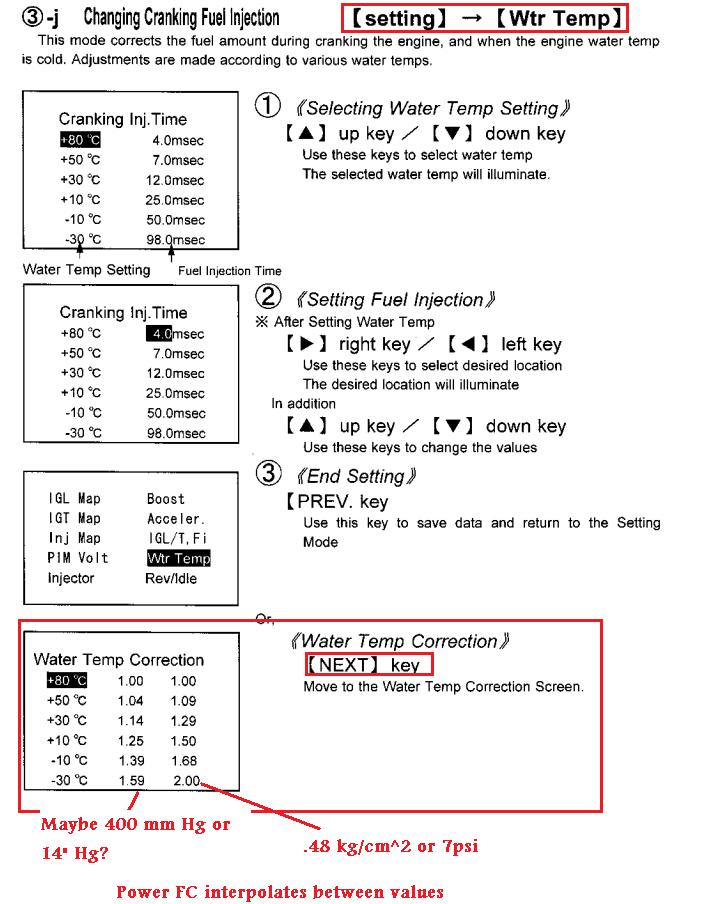
There are two sets of warmup correction values, one for low load (idle mostly) and the other for moderate boost levels. The Power FC is going to interpolate between the temperature breakpoints and interpolate between the two correction values based on whatever the manifold pressure is. A higher number means a greater amount of fuel is added on top of what the normal fuel calculation would be. The two reference values in that pic are me doing a rough conversion of the pressure coordinates given in the datalogit (PIM 4864 for low load and PIM 14848 for higher load).
When I actually tune this, I start the car up and look at the water temperature in the "monitor" screen. Then I try to find the nearest temperature breakpoint and just fiddle with the values at little bit at a time. The car will keep warming up and you will have to play with the whole map. On another session you can start the car up and immediately go driving and start fiddling with the higher load correction numbers. The best thing I can tell you to do is just play with the settings until you are happy with the AFR's that you see, mindful of the fact that ambient conditions change throughout the year and the AFR always fluctuates within a certain range.
Tuning the AFR's after a cold start (under 80C) can be a very time-consuming process that will can take multiple sessions to get right. I usually prefer to use Commander for this because adjustments can be made quickly and you don't need to hassle with a Datalogit and laptop.
This is a more advanced tuning process. Always dial in the AFR's at operating temperature before you attempt to tune warm-up fuel correction. Under some conditions, if your car has insufficient warm-up enrichment it will not idle! This isn't a problem on the default map which is plenty rich. But I've said it before and I'll say it again, it's easy to make your car run worse before it runs better. So be careful
First there is the matter of warm idle AFR tuning. On less modded setups (stock primary injectors) mostly involves adjusting the INJ map in the idle cells found in the map watch feature. I haven't talked about warm idle AFR tuning too much because I am reluctant to encourage novices to attack something as tricky and time consuming armed only with a Commander and this writeup of limited scope. But you need to expect the idle AFR to fluctuate up to half a point of AFR, so maybe from 12.5:1 - 13.0:1 just in normal operation. When the idle AFR gets leaner than 13:1, you increase the chances of hunting and surging. Again, be careful.
With all that out of the way, I'll begin by saying that you may find a car without a cat will be a little smokey (fuel smoke) after initial startup. While this may not be avoidable 100% of the time, you can try to ameliorate it by adjusting the water temperature correction to lean out the AFR. In my experience the car can also tend to run richer than really needed while you are driving it easy during warm up. During warm up IMO there is really no point in running 11:1 AFR's in a cruising range where you would normally be running 14's or 15's. It can be in the 13's or whatever you want it to be, just don't give it much throttle or boost when cold.

There are two sets of warmup correction values, one for low load (idle mostly) and the other for moderate boost levels. The Power FC is going to interpolate between the temperature breakpoints and interpolate between the two correction values based on whatever the manifold pressure is. A higher number means a greater amount of fuel is added on top of what the normal fuel calculation would be. The two reference values in that pic are me doing a rough conversion of the pressure coordinates given in the datalogit (PIM 4864 for low load and PIM 14848 for higher load).
When I actually tune this, I start the car up and look at the water temperature in the "monitor" screen. Then I try to find the nearest temperature breakpoint and just fiddle with the values at little bit at a time. The car will keep warming up and you will have to play with the whole map. On another session you can start the car up and immediately go driving and start fiddling with the higher load correction numbers. The best thing I can tell you to do is just play with the settings until you are happy with the AFR's that you see, mindful of the fact that ambient conditions change throughout the year and the AFR always fluctuates within a certain range.
#22
I wanted to add a section on leaning your car out for an emissions test, although I've never personally had to do this (don't have sniffer tests here anymore). You should have O2 feedback turned on, and your airpump installed and working. You can go into the diagnostic screen on the PFC and temporarily lean your AFR's out across the board. If you have 850 primaries this may not work so well.
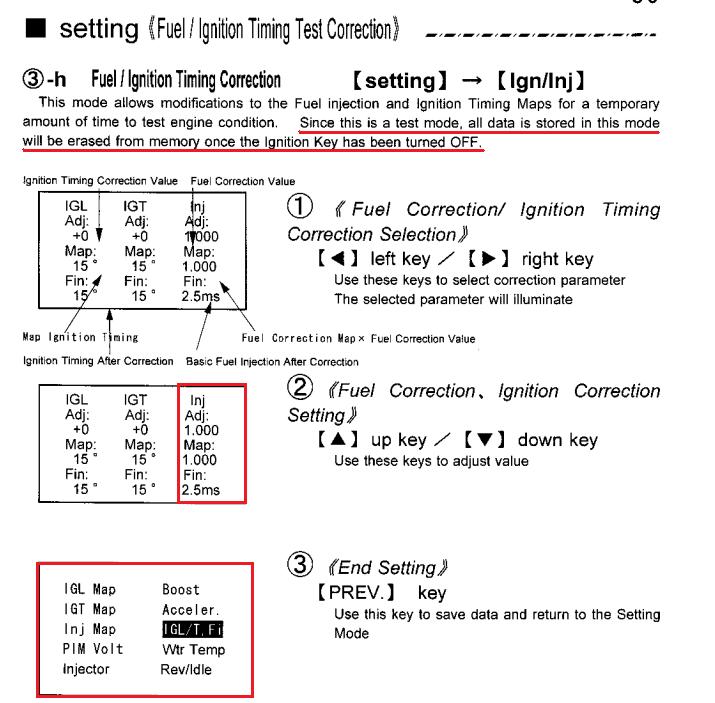
These changes will go away once you turn the car off. Unless you have the factory precat installed, ideally you would want to drive the car hard to heat the cat up, then quickly lean it out with this diagnostic mode before it's pulled into the station.
Just don't boost the car after you lean it out (unless you reset the changes made here). Having a wideband would help when you are messing with it. If your ACV is installed and working right then your AFRs should be very lean at idle because the ACV directs air pump air in order to dilute the exhaust right as it exits the exhaust ports.

These changes will go away once you turn the car off. Unless you have the factory precat installed, ideally you would want to drive the car hard to heat the cat up, then quickly lean it out with this diagnostic mode before it's pulled into the station.
Just don't boost the car after you lean it out (unless you reset the changes made here). Having a wideband would help when you are messing with it. If your ACV is installed and working right then your AFRs should be very lean at idle because the ACV directs air pump air in order to dilute the exhaust right as it exits the exhaust ports.
#23
Advanced Idle Troubleshooting - Fast Idle Cam
I'm going to add in some more stuff about getting your car to idle right after you've performed the baseline TB adjustment procedure mentioned earlier. This first little article is about checking your fast idle system (if still equipped).
Here's what you can do to see if the fast idle cam is affecting warm idle speed (it shouldn't). With the engine cold, bring your Commander into the engine bay. Go to etc.-->sensor/sw check. note the VTA1 and VTA2 values. Now rotate the fast idle cam with your finger. The VTA values should drop, especially VTA2 which is your narrow range sensor that is designed to detect throttle angle at idle. Return the fast idle cam to its normal position.
Now warm the engine up (get it to 82 C or so) and cut it off (you don't have to cut it off but it may make it easier to work back there). Look at your VTA values--they should be lower than before. Perform the same cam rotation test. The VTA values should NOT change as you rotate the cam away from its resting position on the now-extended rod. If they do change (more than say .01 VTA2 volts), your fast idle cam has not fully rotated away, most likely due to adjustment of the cam adjust screw:
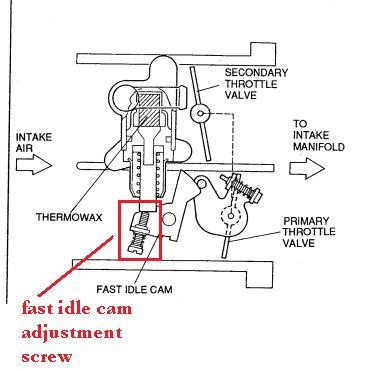
adjust the fast idle cam screw so that, with the engine completely warm, VTA voltages do not change as you physically rotate the cam. Does that make sense? You are just trying to make sure the fast idle system isn't making the throttle plates stick open once the car is at operating temp. The way it works is that the hot coolant makes the rod extend, which rotates the cam. That screw mostly sets the angle of the cam when the rod is fully extended.
I'm not sure how hard it is to get to that screw, I've only adjusted a fast idle cam screw on a 2nd gen turbo throttlebody which has the fast idle cam in a different orientation.
I'm going to add in some more stuff about getting your car to idle right after you've performed the baseline TB adjustment procedure mentioned earlier. This first little article is about checking your fast idle system (if still equipped).
Here's what you can do to see if the fast idle cam is affecting warm idle speed (it shouldn't). With the engine cold, bring your Commander into the engine bay. Go to etc.-->sensor/sw check. note the VTA1 and VTA2 values. Now rotate the fast idle cam with your finger. The VTA values should drop, especially VTA2 which is your narrow range sensor that is designed to detect throttle angle at idle. Return the fast idle cam to its normal position.
Now warm the engine up (get it to 82 C or so) and cut it off (you don't have to cut it off but it may make it easier to work back there). Look at your VTA values--they should be lower than before. Perform the same cam rotation test. The VTA values should NOT change as you rotate the cam away from its resting position on the now-extended rod. If they do change (more than say .01 VTA2 volts), your fast idle cam has not fully rotated away, most likely due to adjustment of the cam adjust screw:

adjust the fast idle cam screw so that, with the engine completely warm, VTA voltages do not change as you physically rotate the cam. Does that make sense? You are just trying to make sure the fast idle system isn't making the throttle plates stick open once the car is at operating temp. The way it works is that the hot coolant makes the rod extend, which rotates the cam. That screw mostly sets the angle of the cam when the rod is fully extended.
I'm not sure how hard it is to get to that screw, I've only adjusted a fast idle cam screw on a 2nd gen turbo throttlebody which has the fast idle cam in a different orientation.
#25
Just wanted to give a little trick i learned when adjusting the fast idle cam. depending on what oil filter you have the adjustment screw can be very hard to get to with a screwdriver. one trick I learned while fixing my idle is that the adjustment screw isn't locked with a nut like the other throttle plate screws are,so its pretty easy to turn, if it seems tough, just spray it with some wd-40 or carb cleaner to remove some of the rust, dust, etc and then us the tab from a coke can to turn the screw while you hold the cam open a little bit to relieve the friction from the waxrod. It worked like a champ for me!




